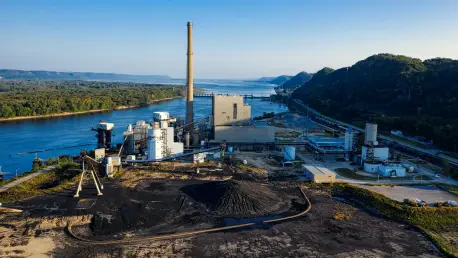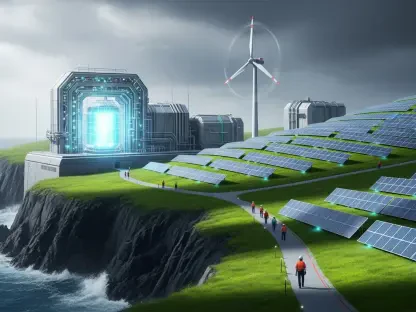Imagine a once-thriving industry, central to powering a nation, now reduced to a shadow of its former self, with communities grappling with job losses and shuttered plants, painting a grim picture for the American coal sector. Over recent decades, its role in electricity generation has plummeted, but in a bold move to reverse this decline, the Trump administration has rolled out an ambitious plan to breathe new life into coal through expanded leasing and substantial funding. This initiative, announced amid heated debates over energy and the environment, promises to reshape the landscape of domestic energy policy while reigniting fierce controversy. What drives this push, and what does it mean for the nation’s future?
Highlighting a Sweeping Policy Announcement
At a recent high-profile event, Interior Secretary Doug Burgum took center stage to declare the opening of 13.1 million acres of federal land for coal leasing across North Dakota, Montana, and Wyoming. This unprecedented expansion marks a sharp reversal of previous restrictions and dwarfs past allocations, signaling a clear intent to bolster coal production on a massive scale. Flanked by coal miners during a press conference, Burgum framed the decision as a lifeline for struggling communities, emphasizing the economic ripple effects of revitalizing mining operations in these regions.
Complementing this land access initiative, the Department of Energy revealed a hefty $625 million allocation aimed at upgrading coal-fired power generation facilities. This financial injection seeks to modernize aging infrastructure and extend the operational life of plants facing closure. Energy Secretary Chris Wright, speaking at the same event, underscored the urgency of maintaining coal as a reliable energy source, particularly to meet surging electricity demands driven by technologies like artificial intelligence.
Notably, the Environmental Protection Agency, under Administrator Lee Zeldin, also announced a relaxation of compliance deadlines for coal ash disposal regulations. This move, intended to ease the regulatory burden on coal operators, addresses the management of toxic contaminants such as mercury and arsenic. Together, these coordinated actions reflect a unified administration strategy to prioritize economic gains and energy security, even as they stir significant contention among stakeholders.
Economic Promises and On-the-Ground Impact
Administration officials, during the announcement, painted a vivid picture of economic renewal, with Burgum asserting that the leasing expansion could preserve or create thousands of jobs in coal-dependent states. The visual of miners standing alongside him served as a powerful symbol of hope for communities that have borne the brunt of the industry’s decline. Supporters like Tom Pyle of the American Energy Alliance echoed this optimism, predicting that up to 38 coal plants might delay planned closures by 2028 due to these supportive measures.
Beyond immediate job prospects, the funding for plant upgrades was touted as a means to ensure energy reliability in an era of unpredictable demand spikes. Wright highlighted specific cases, such as an emergency directive to keep a Michigan coal plant operational, as evidence of coal’s critical role in stabilizing the grid. For many in attendance, these promises resonated as a potential turning point for regions long overshadowed by economic hardship.
Yet, beneath the surface of these pledges lies a complex reality. While the short-term outlook for coal communities may brighten with increased activity, local stakeholders expressed a cautious mix of relief and skepticism. Many workers and residents worry that these gains could prove fleeting, given the structural challenges facing an industry that has seen its workforce shrink dramatically over the past decade. The event captured this tension, as applause for the announcements mingled with murmurs of uncertainty about long-term sustainability.
Environmental Backlash and Expert Skepticism
The celebratory tone of the policy rollout was quickly met with sharp criticism from environmental advocates who decried the administration’s approach. Representatives from groups like the Sierra Club, present at a parallel protest outside the event venue, warned of severe health risks and environmental degradation tied to coal’s high-carbon footprint. Their voices amplified concerns about increased pollution and higher electricity bills for consumers, painting the initiative as a step backward in the fight against climate change.
Adding to the chorus of dissent, industry analysts offered a sobering perspective on the viability of a coal resurgence. Frank Holmes of U.S. Global Investors, commenting during a post-event panel, questioned whether regulatory relief could truly counter market preferences for cleaner alternatives like natural gas and renewables. His analysis pointed to coal’s dwindling share in U.S. electricity generation—now at a mere 15%—as a sign that the industry’s decline may be irreversible, regardless of policy interventions.
This opposition underscored a broader global context, with critics at the event highlighting how the administration’s focus on coal runs counter to international efforts to reduce emissions. The stark divide between economic arguments and environmental imperatives was palpable, as attendees grappled with the implications of prioritizing short-term gains over long-term ecological health. The clash of perspectives set a contentious backdrop to an otherwise triumphant policy launch.
Energy Trends and Technological Realities
Amid discussions at the event, the administration’s push to delay coal plant retirements emerged as a central theme, with officials arguing that coal remains indispensable for meeting sudden energy needs. Wright’s emphasis on coal’s role in supporting cutting-edge sectors like AI drew attention, positioning the fossil fuel as a bridge to future demands. This narrative aimed to reframe coal not as a relic of the past, but as a vital component of a modern energy mix.
However, the absence of innovation in coal technology was a glaring omission during the presentations. Unlike the rapid advancements seen in solar and wind energy, no new strategies or breakthroughs for cleaner coal usage were proposed, raising questions among attendees about the industry’s adaptability. This gap highlighted a disconnect between the administration’s ambitions and the market’s trajectory toward sustainable alternatives, fueling doubts about coal’s relevance in an evolving energy landscape.
The event also shed light on broader sector dynamics, with speakers acknowledging the fierce competition from natural gas and renewables that has eroded coal’s dominance. Despite the regulatory support and funding unveiled, many in the audience pondered whether these measures could genuinely alter the course of an industry facing systemic headwinds. The dialogue revealed a policy caught between nostalgia for coal’s historic role and the hard realities of a shifting energy paradigm.
Reflecting on a Polarized Policy Launch
Looking back on the Trump administration’s coal revival announcement, the event stood out as a defining moment of ambition and division. The unveiling of 13.1 million acres for leasing, coupled with $625 million in funding and eased regulations, marked a determined effort to resurrect a struggling sector. Yet, the sharp pushback from environmental groups and the measured skepticism of analysts painted a picture of deep polarization, with economic hopes clashing against ecological fears.
Moving forward, the challenge lies in navigating this contentious terrain with a balanced approach. Policymakers must weigh the immediate benefits for coal communities against the long-term health and environmental costs, seeking ways to support workers through transition programs if market trends continue to favor cleaner energy. Engaging with stakeholders on both sides to explore hybrid energy solutions could offer a path toward compromise, ensuring energy security without sacrificing sustainability.
Additionally, investing in innovation for cleaner coal technologies or retraining programs for affected workers emerged as critical next steps from discussions at the event. These efforts could mitigate some of the criticism while addressing the structural decline of the industry. As the nation watches the fallout from this bold policy, the focus must shift to crafting strategies that bridge immediate needs with a vision for a resilient energy future, avoiding the pitfalls of temporary fixes in a rapidly changing world.









